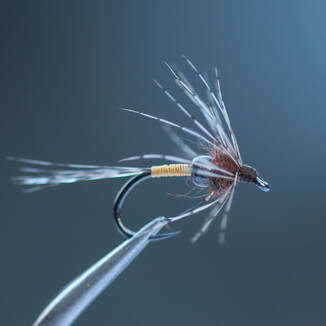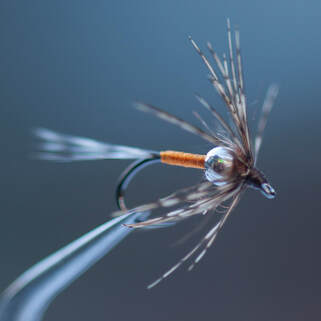The new generation of anglers have deemed the soft hackle fly pattern a new, secret “trout killer” which is highly productive when fished like a nymph or streamer. Well, let’s not ignore the history of the soft hackle. In the 1400s, Dame Juliana Berners list of twelve seasonal fly patterns included the Hackle Fly which was basically the first known soft hackle fly pattern. Moving forward to the 1600s, both hackle flies and spiders were the soft hackle fly patterns of the period. In the 1800s, the North Country flies included a number of soft hackle fly patterns which were the true basis of the modern soft hackle.
Correction, the soft hackle fly is an old, proven “trout killer” which is highly productive when fished using traditional wet fly drifting and tailing techniques. The effectiveness of the soft hackle is due to the fly being the ultimate impressionistic pattern - appearing to look like almost everything on the fish’s hunger list.
The history of today’s soft hackle flies extends even farther back than Dame Juliana Berners' 1496 Treatise of Fishing with an Angle, but Sylvester Nemes' 1975 book The Soft-Hackled Fly gave the deserved attention in the United States, to "soft-hackle" flies. In the past few decades, beading a nymph, streamer or wet fly for both weight and to imitate a bubble has become very popular and possibly overdone. However, soft hackle which at least imitate rising nymphs or Caddis pupa may be beaded uniquely in the center of the hook.
Center Bead Soft Hackle Fly
Placing the bead in the center of the hook shank provides a slight camouflage of the bead and the advantage of the moving the weight away from the hook eye. This gives the fly a more balanced action and movement.
A Center Bead Soft Hackle is a very forgiving pattern if you struggle with achieving a drag free drift. As long as it is in the water, it will produce fish. Dead drifting the fly as a nymph is highly effective but does not take advantage of some of the pattern’s unique properties. The most common and most productive presentation for a Center Bead Soft Hackle is the swing. The hackle has a tendency to trap an air bubble making the fly a natural emerger pattern.
When fishing from a boat, it’s very effective to cast a Center Bead Soft Hackle straight across the current and retrieve it slowly with short strips. A Center Bead Soft Hackle is also effective as a trailer to a dry fly on the surface or a streamer underwater. These tandem presentations work well with a drift and swing presentation as well. The Center Bead Soft Hackle is always a good choice as a dropper or a trailer.
There is just no wrong way to fish a soft hackle. When rising fish refuse everything you offer, the Center Bead Soft Hackle can often save the day. Treat it with some floatant and fish it in the film. As a floating nymph, it will entice the most selective of fish.
Center Bead Partridge & Green
Center Bead Partridge & Orange (see FOTM April’2011)
Center Bead Partridge & Yellow
Center Bead Pheasant Tail Soft Hackle
There are many options in terms of color and material but the anatomy of the soft hackle remains the same. A body, a dubbing ball and a hackle. Some variations include a tail, a center bead, bead head or even bead-chain or dumbbell eyes, but in form and function they are the same.
The choices for the body material are endless. Black, brown and grey are classics but bright colors like chartreuse, red and orange really attract fish at times. Thread bodies are easy and effective. The slim profile of a thread body and sparse hackle is highly effective. Fur or synthetic dubbed bodies work well, especially when ribbed with wire. Pheasant tail is a great choice and available in many colors. Peacock bodies are a classic and the peacock collar or dubbing ball is used on numerous soft hackle fly patterns.
Flashy dubbing and UV dubbing are used on a modern soft hackle as a little something extra for attention. The Center Bead Pheasant Tail and Chartreuse Soft Hackle is tied with ice wing fiber dubbing to create a modern version, attractor soft hackle.
Traditionally, the dubbing ball was made from peacock. The iridescent nature of the peacock adds brightness which suggests an air bubble even when one is not present. Modern soft hackle fly patterns use materials with some inherent flash for the same reason. A shaggier ball helps trap air.
The hackle is a defining characteristic of the pattern. Game feathers like partridge are the most common choice but hen, guinea and larger sized mallard all provide the soft material needed. These soft hackle barbules allow the fly to sink and as the fly pattern tails out, the hackle fibers lay back over the body trapping the air bubble and making the fly highly attractive. Soft hackle fly patterns may be tied with a shorter collar to appear more like a rising nymph or with a longer collar to appear more like a Caddis pupa.
Experiment with colors and materials and sizes. Keep the proportions much the same as you would when tying nymphs. Choose hackle feathers with barbules about 1 1/2X the length of your hook gap and no longer than the shank. Sparse is better. Two turns is typically plenty.
Soft hackle fly patterns may be unweighted weight with non-toxic lead substitute wire wrapped as an underbody, bead-headed or center-beaded, tungsten beaded to get down deep or glass beaded for attraction. John Gierach ties a Hare’s Ear Soft Hackle with bead chain eyes.
As anglers, we look for innovation and a fool proof means of catching fish. Hot new patterns catch fish. In contrast, the soft hackle has evolved very little from its inception. It is a highly productive design that has not been improved upon. Many modern fly anglers overlook traditional soft hackle patterns that are as effective today as ever and has been proven on streams around the world for hundreds of years.
Center Bead Partridge & Green
Center Bead Partridge & Orange (see FOTM April’2011)
Center Bead Partridge & Yellow
Center Bead Pheasant Tail Soft Hackle
Fly of the Month 12.21
Tom Adams and Alen Baker
Center Bead Soft Hackle
Recipe :
Hook : Wet fly hook, Tiemco 3769 or equiv in size 8,10,12,14,16,18
Thread : Color to match pattern 8/0
Bead : Brass or tungsten to match hook size
Body : Pearsall Gossamer or equiv to match pattern
Wing : Hungarian Partridge or equiv soft hackle feather
Thorax : Hare’s Ear plus dubbing or equivTail : CDL, Rooster, Zelon, Antron, Darlon, hot spot
This is a very flexible pattern and can be tied in most soft hackle colors and materials. The addition of the bead makes the fishing characteristics varied from the traditional. The colors are not listed because the choices are as varied as soft hackles are. Possibilities are limitless.
Directions :
Recipe :
Hook : Wet fly hook, Tiemco 3769 or equiv in size 8,10,12,14,16,18
Thread : Color to match pattern 8/0
Bead : Brass or tungsten to match hook size
Body : Pearsall Gossamer or equiv to match pattern
Wing : Hungarian Partridge or equiv soft hackle feather
Thorax : Hare’s Ear plus dubbing or equivTail : CDL, Rooster, Zelon, Antron, Darlon, hot spot
This is a very flexible pattern and can be tied in most soft hackle colors and materials. The addition of the bead makes the fishing characteristics varied from the traditional. The colors are not listed because the choices are as varied as soft hackles are. Possibilities are limitless.
Directions :
- Debarb and mount the hook with the bead in place. Attach the thread ( in this case Pearsall’s ) slightly forward of the half mark.
- Begin forming a small thread ball but first verify the spot by moving the bead into a temporary place. Allow sufficient room for dubbing and the soft hackle in front of the bead. The thread ball will go “into” the bead so take that into account when forming it. The bead will stay forward at this point
- With the thread on the shank immediately behind the thread ball, select the tailing material ( in this case 6-8 CDL barbs ) and secure on top of the hook shank after measuring the length ( about one and one half the hook shank ). Make tight touching turns with no overlapping to the hook bend. Trim any tailing waste at the hook ball and advance the thread in tight touching turns with no overlaps until reaching the thread ball. At this point there are two ways to secure the bead.
- Bring the thread over the bead and make several wraps in front, trapping the bead
- Whip finish the thread immediately behind the thread ball and cut away the thread. Use a small amount of cement, and push the bead onto the thread ball. Tie in new thread if you are changing threads and make several wraps in front of the bead to secure the bead.
- Bring the thread over the bead and make several wraps in front, trapping the bead
- Select dubbing and dub about two inches of thread. Wrap dubbing immediately in front of the bead. Tease out the dubbing as desired and stroke back toward the hook bend to “cover” the bead.
- Select the soft hackle feather and form a small vee at the tip of the feather to tie in. Cut the vee to the smallest practical length and tie in in front of the bead. Use hackle pliers and make one and one half to two turns of hackle, stroking back the fibers as you wind (to prevent trapping the overlapping fibers). Secure with two thread wraps to the stem only and cut the stem as close to the thread as possible. While holding the barbs back with one hand secure with three or fours wraps ending with the thread close to the dub thorax. Check the distribution of the barbs and then form a nice thread head. Whip finish and trim the thread.




